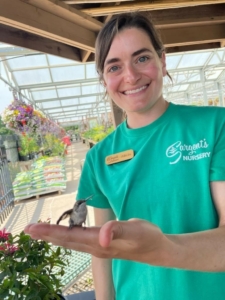
Beetles, Slugs, and Powdery Mildew, Oh My! Pest and disease control in the garden can be a very difficult and frustrating task for many people. There is nothing worse than seeing a problem arise on your favorite plant and not knowing what’s wrong! Don’t panic, we are here for you.
As gardeners, we have an advantage. We can learn from our mistakes and consult endless resources on how to out-smart these problematic pests and diseases before they even arise. The number one thing we can do is choose our plants wisely. Set yourself up for success by choosing plants that are resistant to undesirable pests, diseases and wildlife. There are many great choices out there, it’s just a matter of taking the time to study your landscape and do a little research to get the right plants into place!
When action must be taken, we recommend using a method called Integrated Pest Management (IPM). This includes long term solutions to problems that are better for you and the environment.
Step 1. Monitor and scout insects to determine which insect types and their population levels in your garden area, and check your plants regularly for signs of disease.
Step 2. Accurately identify your pests. There are many online resources to help you properly identify your problem. The UMN Extension website has a great diagnostic tool that is easy to use and can be very helpful: https://apps.extension.umn.edu/garden/diagnose/plant/
Step 3. Assess and consider economic or aesthetic injury thresholds. Is the cost of controlling the pest equal to the damage it is causing? Does the damage caused by the pest only affect the way the plants look, and not their overall health? Remember to keep an open mind about imperfections in your plants. Holes on leaves can sometimes be a sign of mutually beneficial relationships between pollinating insects and host plants. Sometimes, we have to remember what we learned in kindergarten: SHARE! Within reason, a small amount of insect damage is normal and will not affect the overall health of your garden.
Step 4. Implement your treatment strategy using mechanical, cultural, biological, or chemical controls. You can also use a combination of these strategies depending on your situation.
Mechanical: This is the use of physical means to control pests such as handpicking insects, adding traps and barriers, pruning, raking, and spraying with water.
Cultural: Make necessary changes to the living conditions of your plants. Make sure your soil is healthy and select disease resistant plants based on your environment.
Biological: Try introducing beneficial or parasitic insects like lady-beetles or conserving natural enemies. There are selective natural pesticides available like Bonide Bt (Bacillus thuringiensis) that do not negatively affect other beneficial species.
Chemical: If the pest or disease has been correctly identified and is still a problem after ALL other management strategies have been implemented, chemical options may be considered. This is a last resort option and should be avoided whenever possible. Herbicides are available to kill weeds, insecticides to kill insects, and fungicides and antibiotics to manage diseases. It is imperative that the selected chemical is labeled both for management of the offending pest and for use on the specific type of plant upon which it is to be sprayed. All users are legally required to follow the instructions on the pesticide label including the amount and timing of application. With that in mind, please use insecticides wisely, as directed, and sparingly. NEVER use a systemic insecticide on any edible plants!

Beetles, Slugs, and Powdery Mildew, Oh My! Pest and disease control in the garden can be a very difficult and frustrating task for many people. There is nothing worse than seeing a problem arise on your favorite plant and not knowing what’s wrong! Don’t panic, we are here for you.
As gardeners, we have an advantage. We can learn from our mistakes and consult endless resources on how to out-smart these problematic pests and diseases before they even arise. The number one thing we can do is choose our plants wisely. Set yourself up for success by choosing plants that are resistant to undesirable pests, diseases and wildlife. There are many great choices out there, it’s just a matter of taking the time to study your landscape and do a little research to get the right plants into place!
When action must be taken, we recommend using a method called Integrated Pest Management (IPM). This includes long term solutions to problems that are better for you and the environment.
Step 1. Monitor and scout insects to determine which insect types and their population levels in your garden area, and check your plants regularly for signs of disease.
Step 2. Accurately identify your pests. There are many online resources to help you properly identify your problem. The UMN Extension website has a great diagnostic tool that is easy to use and can be very helpful: https://apps.extension.umn.edu/garden/diagnose/plant/
Step 3. Assess and consider economic or aesthetic injury thresholds. Is the cost of controlling the pest equal to the damage it is causing? Does the damage caused by the pest only affect the way the plants look, and not their overall health? Remember to keep an open mind about imperfections in your plants. Holes on leaves can sometimes be a sign of mutually beneficial relationships between pollinating insects and host plants. Sometimes, we have to remember what we learned in kindergarten: SHARE! Within reason, a small amount of insect damage is normal and will not affect the overall health of your garden.
Step 4. Implement your treatment strategy using mechanical, cultural, biological, or chemical controls. You can also use a combination of these strategies depending on your situation.
Mechanical: This is the use of physical means to control pests such as handpicking insects, adding traps and barriers, pruning, raking, and spraying with water.
Cultural: Make necessary changes to the living conditions of your plants. Make sure your soil is healthy and select disease resistant plants based on your environment.
Biological: Try introducing beneficial or parasitic insects like lady-beetles or conserving natural enemies. There are selective natural pesticides available like Bonide Bt (Bacillus thuringiensis) that do not negatively affect other beneficial species.
Chemical: If the pest or disease has been correctly identified and is still a problem after ALL other management strategies have been implemented, chemical options may be considered. This is a last resort option and should be avoided whenever possible. Herbicides are available to kill weeds, insecticides to kill insects, and fungicides and antibiotics to manage diseases. It is imperative that the selected chemical is labeled both for management of the offending pest and for use on the specific type of plant upon which it is to be sprayed. All users are legally required to follow the instructions on the pesticide label including the amount and timing of application. With that in mind, please use insecticides wisely, as directed, and sparingly. NEVER use a systemic insecticide on any edible plants!

We must remember that insecticides that get rid of undesirable insects also can harm our beloved pollinators. Pollinators are a crucial part of our ecosystem and food supply. We must take the time to understand the roles that insects play in order to manage our gardens in a way that protects the health of our environment.
Integrated Pest Management is a great tool to help us safely and effectively solve problems that arise in the garden, but let’s talk about some ways we can avoid pests and diseases before they start:
Disease:
- Plant seeds from a reputable source. If you reuse seeds from year to year, make sure to collect seeds from a disease-free plant and treat them with hot water to avoid transferring any pathogens.
- Rotate vegetable crop families regularly.
- Clean your shoes before entering the garden and wash your hands and gloves regularly.
- Use trellises to support plants and provide better airflow.
- Sanitize your tools regularly and make sure all trellises and other support systems are cleaned before you start your garden for the year.
- Use drip irrigation if possible or avoid splashing the leaves when watering.
- Remove infected plants right away to avoid spreading the disease. It is recommended to remove diseased plants or leaves when they are dry and no rain is forecasted to avoid transmitting pathogens into the soil.
- Keep compost away from garden beds and make sure it is fully composted before applying.
- Keep your garden weed free and tidy throughout the season, making sure to dispose of any plant matter that shows signs of disease.
- Choose native plants that are disease resistant!!
Pests and Wildlife:
- Conserve natural enemies of pests by avoiding use of chemical treatments whenever possible. Use companion planting to help promote beneficial insects. Example: Dill attracts lady beetles which eat aphids and spider mites!
- Remove brush piles and other unused plant matter that may provide a habitat for pests.
- Use non-toxic repellants when possible. You may need to reapply these repellants frequently to be effective.
- Install fencing and other barriers around plants, especially vegetables.
- And again, when possible, choose native plants that are pest resistant!! 😊
Sargent’s Nursery provides a wide variety of products to help you integrate IPM methods to your garden. From traps and preventatives, to natural and synthetic chemical treatments, we have it all! Notice a problem? Take a deep breath–and a picture–and come see us!

This blog post is brought to you by Alicia, an employee of Sargent’s Nursery, whom you may have seen watering annuals in the greenhouse in the past.
She now travels the country, excitedly sharing her knowledge and experiences in gardening with you. And hey, she even saved a hummingbird once with a sticky wing.
Check back for more from Alicia and come along for the ride!


